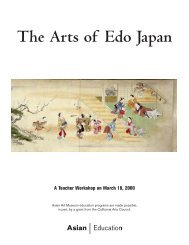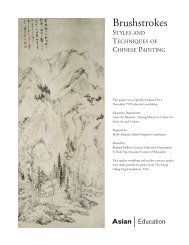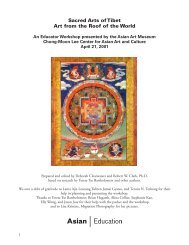China:The Glorious Tang And Song Dynasties - Asian Art Museum ...
China:The Glorious Tang And Song Dynasties - Asian Art Museum ...
China:The Glorious Tang And Song Dynasties - Asian Art Museum ...
You also want an ePaper? Increase the reach of your titles
YUMPU automatically turns print PDFs into web optimized ePapers that Google loves.
highly symbolic—images conveying messages about abundance, harmony, fecundity, heroism,<br />
stability, and strength. Some rulers emphasized military prowess and authority through the arts.<br />
Others preferred images of refinement and championed visual art that was very delicate or austere.<br />
• <strong>Art</strong> by and for the educated elite: Scholarly forms of art that conveyed knowledge of the past,<br />
demonstrating the artist-author’s achievement and education through “quotations” from past<br />
masters; an art that ran contrary to professional art (theoretically not exchanged for wages),<br />
beginning in the <strong>Tang</strong>-<strong>Song</strong> period, but more developed in later periods.<br />
<strong>The</strong>re was of course overlap among these product categories. For example, an object might have<br />
been produced locally, given as tribute to court, used at court, and then buried as a prized possession<br />
in the tomb.<br />
We often think of art as something exceptional or extraordinary, and might ask why very ordinary,<br />
utilitarian objects would be considered alongside exceptionally unique paintings or sculptures.<br />
Yet many Chinese products, especially those for export such as certain ceramic wares, silk, lacquer,<br />
printed books, and tea, were finely produced and virtually unsurpassed anywhere else in the world.<br />
To the local Chinese producer, such products might have seemed “stock in trade,” but elsewhere<br />
they were highly sought after and indeed probably viewed as prized possessions. In fact, during the<br />
<strong>Tang</strong>-<strong>Song</strong> period, fine objects such as silk were often used as currency or bribes to keep foreign<br />
powers from attacking <strong>China</strong>.<br />
Even the most prized possessions, such as the collections amassed by both <strong>Tang</strong> and <strong>Song</strong><br />
emperors, were never completely secure. <strong>The</strong> <strong>Tang</strong> capital of Chang’an (modern day Xi’an) and the<br />
Northern <strong>Song</strong> capital at Kaifeng were both overrun and in large part demolished at different times.<br />
Works of art were frequently confiscated or destroyed. We can only imagine the full extent of what<br />
once existed during these glorious eras of Chinese culture.<br />
3. BRIEF BACKGROUND ON: A) CHINESE CERAMICS, B) BUDDHIST ARTS, AND C) PAINTING AND<br />
CALLIGRAPHY.<br />
3a) Chinese ceramics<br />
We should begin by asking what some students probably ask—why bother studying ceramics? In<br />
the West, we traditionally look on ceramics as a kind of folk art or humble utilitarian ware. That is<br />
hardly true of ceramics in <strong>China</strong>, where the very name “china” is historically derived from its association<br />
with fine dinnerware. Still, why should study these objects? What’s so special about “china”<br />
and why is it important during the <strong>Tang</strong> and <strong>Song</strong> dynasties?<br />
It’s important to remember that for almost 1,000 years, roughly beginning with the <strong>Tang</strong><br />
dynasty and continuing till about the 1700s, the Chinese produced the world’s best high-fired<br />
ceramics. Chinese potters were exceptionally creative and technically inventive. <strong>The</strong>y also had<br />
important resources at their disposal: clays, wood, and coal for heating kilns. High-fired wares were<br />
often more durable than low-fired wares, and their glazes were less likely to flake. High-fired ceramics<br />
were also highly sought after by non-Chinese peoples. Such ceramics often replaced, or supple-<br />
49
















